Halo Infinite campaign: the Digital Foundry analysis
Tech issues aside, this is a simply brilliant game.
Halo Infinite is a brilliant game. Honestly, against the odds, I feel that 343 has delivered one of the best first-person shooters of the last decade. It's a release that far exceeds the studio's previous work on Halo 4 and 5 in terms of design and in nailing the 'combat sandbox' experience. Worries I had about the transition to an open world have been assuaged and despite the seemingly difficult development period, I simply love the game. Is it perfect? Certainly not. There are numerous tech issues to address and fundamentally, I'm not sure this is the game that was originally envisaged based on reviewing early marketing assets. Regardless though, you've got to play it.
Let's tackle the thorny issue of the open world first. The gradual shift in the games business away from linear design to wide-open play areas crammed with busy work and filler content is becoming a real issue - franchise titles like Far Cry and Assassin's Creed exhibit these issues at their worst. Thankfully, Halo Infinite's approach to level design works brilliantly, just as the preview build suggested, taking the foundational building blocks of Halo 1's second mission and expanding it into something far larger in scope. It works and it retains much of what makes Halo special while introducing a level of freedom that feels like a natural extension. Think OG Crisis rather than latter-day Far Cry and hopefully you'll get some idea of what I mean.
Halo Infinite is built around the concept of a broken Halo ring - look to the distance and you'll see pieces floating in space, disconnected from one another. As you progress, you explore these pieces and they basically serve as mission zones - again, comparable to the second mission of Halo 1 but larger. You always have a main objective, just like a classic Halo game, but the width of the mission has been expanded allowing you to find your own way. The various outposts scattered around the map are optional but offer tangible rewards, such as vehicles, once taken. There's never so much content as to feel overwhelming - you don't feel as if Halo is a giant checklist of tasks - and this is ultimately why it works where so many modern open world games fail.
While there's macro-scale, detail at the micro level also impresses. Weapons, structures, enemies and other objects all feature plenty of granular detail. You can walk up to and zoom in on many an object and it holds up well. You can see that a lot of love was poured into building these elements to populate the world. There's a real density to the environments but also legibility - it's easy to parse each scene but it never feels sparse. The striking contrast between more natural surfaces and the hexagonal structures visible across the world is genuinely excellent most of the time. In addition to moving Halo into a larger world, Infinite also marks the first time the series has tackled a day/night cycle - infiltrating a base at night feels different than taking it head-on mid-day, but lighting such a world is difficult.
In the case of Halo Infinite's SlipSpace engine, the team has shifted to a fully real-time lighting system with diffuse global illumination handled via a probe system. These probes contain the lighting data which is sampled across the world allowing for objects to appear indirectly lit. This system allows for a real-time update which is crucial when you have a dynamic time of day but the approach to lighting the world has some limitations which I'd like to touch on. Halo Infinite doesn't really seem to handle indirect specular lighting especially well. It's basically lacking indirect shadows entirely which I believe ties into the reason why it looks the way it does outdoors. While exploring indirectly lit areas, for instance, you'll notice a prominent 'blueish glow' due to how specular lighting is handled - it could look more natural with a different solution.
However, the main issue is the way in which shadows are handled. Currently, Halo Infinite leans primarily on cascaded shadow maps and some screen-space ambient occlusion and that seems to be basically it. Problem is - there are a lot of huge vistas in this game where you can see miles into the distance. The shadow map cascade distance is relatively aggressive so as you move away from objects, you'll see shadows disappearing and there's no fall back for anything other than large scale distance shadows. Compare and contrast with, say, Red Dead Redemption 2's open world and the difference is vast. This problem isn't new and has been addressed to a certain extent in many years - Unreal Engine 4, for example, allows for signed distance fields which give the required effect at a relatively low cost to the GPU. The dream would be a ray-traced global illumination system as seen in Metro Exodus, which truly looks a generation apart.

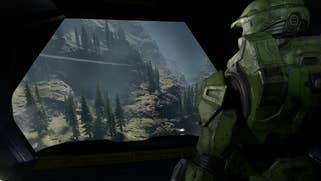



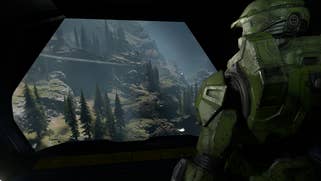
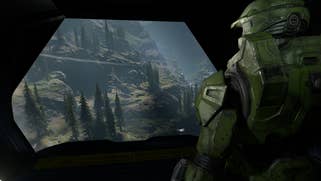



































Still, despite all this, I do think the world is generally attractive thanks to its huge vistas and unique terrain design. It's certainly more inspired than the typical open world environment and there are some features designed to improve the overall look. Volumetric fog is used throughout, lending the environment some additional depth - especially evident during sunset. Meanwhile, the skyboxes impress thanks to 343's use of some kind of procedural system that allows for dynamic, constantly changing cloud cover. The rest of the skybox is attractive with a starry expanse, ships and the halo ring itself filling the horizon. In addition, a cloud shadow layer is used across the terrain - this at least helps offset the lack of typical distance shadows and breathes additional life into the environment.
In terms of the way the environment is represented, I feel the lighting in the open world falls short but the overall scene complexity, the quality of the simulation and the way in which is feeds the gameplay is incredibly well done - and that simulation is a huge part of the experience. Halo Infinite features physics where it counts, I would say. There's a kinetic energy to the way in which the game feels - each weapon has a different impact on different enemies and objects in a way that feels highly dynamic. The size and scale of the battles and the distance from which you can choose to engage is genuinely unique. Many games have promised this sort of gameplay experience but none offer the level of freedom you get in a Halo firefight. I can't stress this enough - 343 finally got this right - this is possibly the best Halo has ever played. It feels both faithful to the original but also improved in its own right.
Halo Infinite isn't just about the open world, though. In fact, the game starts with a brace of interior missions that are beautifully designed, whether it's the initial Halo-like ship design or the awesome new take on the classic Forerunner architecture. These elements are defined by the original Halo of course and thus its angular shapes run the risk of appearing simplistic in a modern game. However, more than any of their prior releases, 343 has found a perfect balance - the silhouette of the architecture is retained but in-surface detail is massively increased lending it a very modern appearance. It's honestly one of the most beautiful environments in Halo Infinite. Beyond this, the Forerunner architecture also showcases exceptionally well-done screen-space reflections.
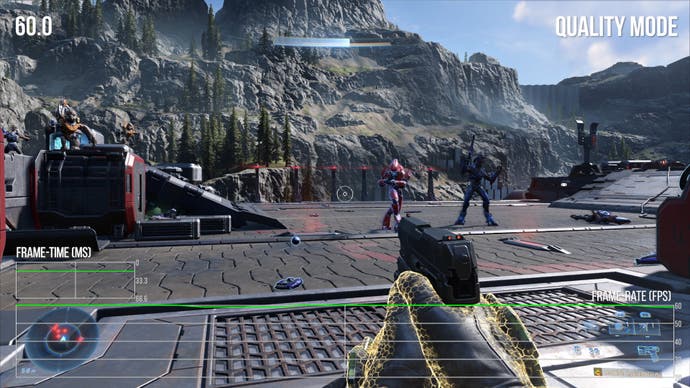
The initial 'handshake' levels also demonstrate that combat is pitch-perfect, with a re-introduction to classic Halo opponents. From Grunts to Brutes and Elites, the new models are beautifully crafted, perfectly matching the classic Halo aesthetic while improving the overall level of model and texture detail. In addition, the animation and AI work on enemies is top notch - the way they react to your attacks and behave as their allies go down breathes new life into the combat. This is an area Halo has always excelled and Infinite carries this tradition forward.
Also worthy of being singled out for particular praise is the audio - a central pillar of the Halo experience. Not to put too fine a point on it but Halo Infinite delivers one of the best-sounding series entries in years. It starts with the soundtrack. Marty O'Donnell's iconic score defined the sound of Halo and since his departure from the series, 343 Industries has struggled to hit the right tone. Halo 4 and 5 have excellent soundtracks, don't get me wrong, but Halo Infinite is truly a return to form in a way that completely floored me. This is thanks to a remarkable trio consisting of Curtis Schweitzer, whose background lies primarily in TV and short film, Joel Corelitz who contributed to the sound of Death Stranding while composing The Unfinished Swan and The Tomorrow Children. Finally, there's Gareth Coker who is responsible for the legendarily brilliant Ori soundtracks. While O'Donnell's original themes run throughout, the bulk of the soundtrack carries its own themes and has a huge impact on the mood of the game from quite tension-building tracks to powerful combat soundtracks through to epic soundscapes that combine perfectly with the stunning Forerunner architecture to deliver something truly special.
At this point, maybe we should go back to rendering basics. This piece is mostly based on my experiences playing Xbox Series X - so expect my colleagues to present a cross-platform analysis soon. Two modes are offered on Microsoft's top-end console. Quality mode at 60fps is the best way to play. It leans into dynamic resolution to maintain performance, much like Halo 5, but the game always looks crisp and doesn't seem to drop beneath 80 percent resolution scaling on both axes. Performance mode aims for 120fps with a max resolution of 1440p but minimums can drop beneath 1080p when things get heated. With the exception of occasional frame-drops, the quality mode is fine running at 60fps, but performance is far more variable in performance mode. Normally, the system's variable refresh rate support would handle any resulting stutter but in my experience, it doesn't work with Halo Infinite - something that needs addressing.
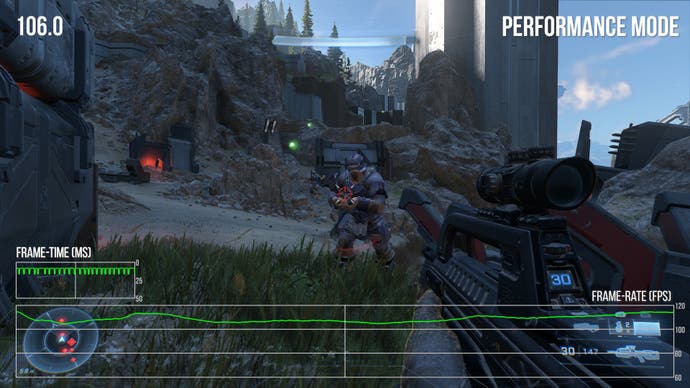
Curiously, Halo Infinite game leans heavily on variable rate shading or VRS - this technique, to put it in very simple terms, effectively varies the amount of GPU power spent on different parts of the screen based on complexity. The effectiveness of the VRS implementation varies based on a number of factors and in the case of Halo, it exhibits noticeable artefacts, especially when combined with temporal anti-aliasing. As a result, it can look a little fuzzy in motion. To offset this, I would suggest reducing the sharpness in the video menu to no more than 25 percent - I feel this helps produce a cleaner looking image while in motion. There are other interesting settings here as well including the option to disable speed lines while sprinting. Overall, image quality is acceptable in most situations.
Performance is mostly sound, then. However, perceptual performance in cutscenes and with in-game animations was an issue in the preview build and has not been corrected for the final game. Also bizarre is that while the game runs at 60fps or 120fps on Series X, facial animations seem to run at half-rate, creating a serious visual continuity. Let's be clear, the composition and detail in the cutscenes is excellent, but their choppiness in motion is seriously off-putting. Put simply, camera and character movement doesn't appear fluid, while facial animations look off. The renderer is updating as it should, but there's something seriously wrong in the update of the content itself. Thankfully, 343 has contacted us via Microsoft PR to tell us that this is being addressed in an upcoming, post-launch patch but it is surprising to see it at all, especially as reviewing Halo Infinite marketing materials from the controversial 2020 gameplay trailer and even earlier cutscene showcases reveals none of these issues.
In-game, there are other puzzling technical problems. We've talked in the past about reloading and mantling animations running at lower frame-rates (again, not present in the 2020 gameplay reveal) but also strange is how lighting interacts with dynamic objects. Playing through many scenes, you get the impression that enemies don't fully blend in with the environment - so an enemy character in a red room appears to be lit white by an invisible light source. Going back to prior Halo games, I didn't see any equivalent issue, to the point where I wonder if this is an attempt to improve visibility. Also curious is how the view weapon and Master Chief's hands warp in motion - but only in the open world. This one is interesting in that it can also be observed in older Halo titles.
Other issues? I wonder if there are some memory management problems 343 need to address. Several time during my gameplay experience, Halo Infinite would freeze for a short while for seemingly no reason. It looks and feels like a crash, only the game comes back and works just fine several second later. It's very, very bizarre when it happens but it seems like something that could be fixed. Also, after extended play, I started to notice textures visibly loading and unloading when simply turning the camera.
My feeling is that Halo Infinite is a truly great game - but one that has some egregious flaws that really need to be addressed. Once the problems are fixed, I think we're looking at a Halo game for the ages. Honestly, the structure and progression of the game is exactly what I had hoped for in the first place - breaking up the world into multiple chunks allows for pacing that matches classic Halo while still expanding on the gameplay opportunities. I'd also like to commend 343 for its exhaustive options menu - there are so many adjustments that can be made to fine tune the experience. From controls, including configuring a mouse and keyboard for play, to visual features, sound, the UI and accessibility, it's absolutely packed.
I ended my analysis by going back to where it began - the original Halo Infinite reveal back at E3 2018. It was a magical moment for Halo fans and was meant to serve as a technical demo for the SlipSpace Engine that would power the game. The thing is, based on this footage, it sure seems like 343 was really onto something - something quite different to the game that was actually delivered. The natural environments are stunningly lit and shaded, it's superbly detailed and evocative. With varying biomes, astonishing vistas, incredible wildlife and much, much more, this was a vision for Halo quite unlike anything we'd seen before. And for all of its successes with Halo Infinite, we still haven't seen that. Make no mistake, Halo Infinite is a stunning game - but it's not built specifically for next-gen hardware. Check out the game on Xbox One X, it's actually very good! Which leads me to wonder that if 343 Industries can achieve something this good with Halo Infinite, perhaps we've already had a taster of the experiences to come once the Xbox One era is finally over.
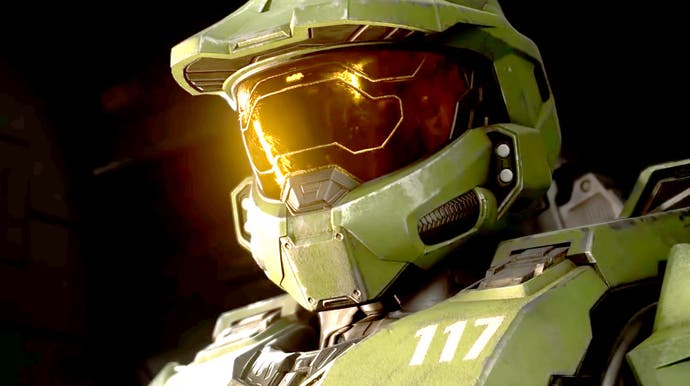





.jpg?width=291&height=164&fit=crop&quality=80&format=jpg&auto=webp)




